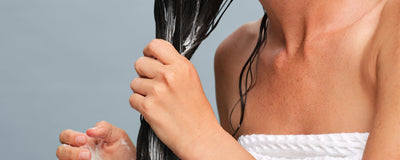For many women, perimenopause marks the beginning of a new chapter – one that can last a few months to 10 years before menopause officially begins. The early signs of perimenopause can be subtle, but the closer you get to menopause, the more you will notice the changes in your hair health. The good news is that with the right haircare, you can still have your best hair during perimenopause and beyond.

Waking up in the night with hot flashes or experiencing new emotional ups and downs is bad enough, but then there’s the unwanted changes to your hair – perimenopause can leave you with thinning, dry, greying, and coarse hair. These changes are natural, but that doesn’t mean you can’t still have your healthiest, most vibrant hair during this transition.
Here’s how I advise my clients to approach this season of life with confidence, the right haircare, and the power of clean beauty:
What Happens to Your Hair During Perimenopause?
Like many of the other symptoms you may experience during perimenopause, changes in your hair can creep up on you slowly. This is because your estrogen and progesterone levels decline gradually, while your androgen levels (like testosterone) become relatively higher. These fluctuations can directly affect your hair follicles and your overall scalp health.
Common hair changes during perimenopause can include:
-
-
Thinning or shedding due to shorter hair growth cycles.
-
Loss of pigment as melanin production slows.
-
Texture changes, including coarseness, dryness, or frizz.
-
Scalp irritation such as dryness, itching, or flaking.
-
During perimenopause, it can be frustrating finding yourself dealing with a whole new list of haircare needs. You may notice that your regular haircare is no longer delivering the results that you want. You may also find yourself turning up the heat on your styling tools to try and combat coarser, unruly strands.

As a Trichologist (hair and scalp health expert) and a haircare product designer, I know that a proactive approach to hormonal changes and hair aging is the best way to have your best hair during perimenopause and into menopause.
Maintaining Your Hair Health Through Perimenopause
The best way to support your hair is from the inside-out with targeted nutrition that can boost hair growth, thickness, and delay grey hair growth. That’s why Arey’s core haircare product is our hair supplement Not Today, Grey. Grey hairs are often one of the first noticeable changes in your hair during perimenopause.

When it comes to perimenopausal hair health, you may also notice thinning hair and an increase in hair shedding. Hair thinning and shedding are related to nutritional deficiencies and drops in your estrogen levels which can shrink your hair follicles and shorten your hair growth phase.

How Not Today, Grey supports your perimenopausal hair:
-
Structural support: vitamin D and B7 help improve the protein structure of each strand for thicker, more resilient hair.
-
Dietary support: nutrients like copper, vitamin B12, iron, and folate support hair growth, shine, and health.
-
Pigment support: vitamin B12 and the Chinese medicinal herb Fo-Ti help your hair follicles (roots) to produce more pigment.
The good news about going grey is that only 30% of the reason you go grey is down to your genetics. That means there’s a lot you can do to slow, delay, and even reverse grey hair. In our gold standard clinical trial, we saw dramatic differences between the participants using The System – a combination of Not Today, Grey, and To The Root® – and the participants who received the placebo. Read more here about Arey’s Gold Standard Clinical test results.
Perimenopause Hair Texture Changes
Many women report that their once-silky hair starts feeling coarser and less easy to style during perimenopause. It can be frustrating during perimenopause when you’re struggling to regain the smoothness and shine that you are used to. And it can be overwhelming when you’re trying to figure out what your new hair needs from your haircare.

The drop in estrogen and progesterone levels can cause dry skin all over your body, and your scalp is no exception. The hormonal fluctuations mean that your body is producing less of the natural oils (sebum) that moisturize your skin and scalp. Less sebum means a less acidic pH on your scalp, and that affects your hair strands too.
3 Ways Perimenopause Affects Your Hair Texture:
#1 Perimenopause means less moisture:
-
The problem: rough, dull hair. Drops in sebum levels affect the outer layer (cuticle) of each hair strand, leaving hair rough and dull.
-
The solution: deep hydration. Switch out your daily conditioner for a deep treatment conditioner like Masque that is designed to replace the moisture your hair is losing. And if you’re heat-styling, don’t skip the heat protectant.

#2 Perimenopause means changes to your hair roots:
-
The problem: more textured hair. Dry scalp skin from hormonal changes actually changes the shape of your hair follicles (roots) which can cause hair to become wavier or curlier.
-
The solution: treat your scalp. A gentle, moisturizing scalp exfoliant like Scrub supports your scalp health by cleansing away buildup and restoring moisture. It also delivers nutrients to support hair growth and pigment. You can also calm coarse hair with Masque deep treatment conditioner.

#3 Perimenopause means more grey hair:
-
The problem: greys are naturally coarser. Bottom line, the more greys you have, the more texture changes you’ll notice.
-
The solution: delay the greys. Start with nutritional support and then add in Arey Mela-9® products that are designed to slow, delay, and even repigment grey hair.

Having your best hair during perimenopause is about using proactive haircare designed for the needs of aging hair. Starting with a gentle cleansing shampoo and then adding in the level of hydration you need – either regular conditioner or a deep treatment conditioner.
Building Your Perimenopause Haircare Routine
Consistency is everything. By starting early, you can create a haircare routine that will help deliver your best hair into menopause and beyond.

Arey, for Your Best Hair at All Life Stages
Perimenopause is the start of a long journey. By prioritizing clean, nourishing care now, you’ll create a strong foundation for menopause and post-menopause years.
We know perimenopause can be a challenging time for your hair – that's why we offer up to 25% off on all subscription orders to help keep you on track with your hair health goals. Because we believe that science + consistency = results.
We are Arey.
Have questions? Check out our FAQ page or say hey@areygrey.com.

Meet Arey’s Deep Hair Conditioner – Inspired by Customer Feedback

5 Top Hair Growth Foods for Thicker, Healthier Hair



